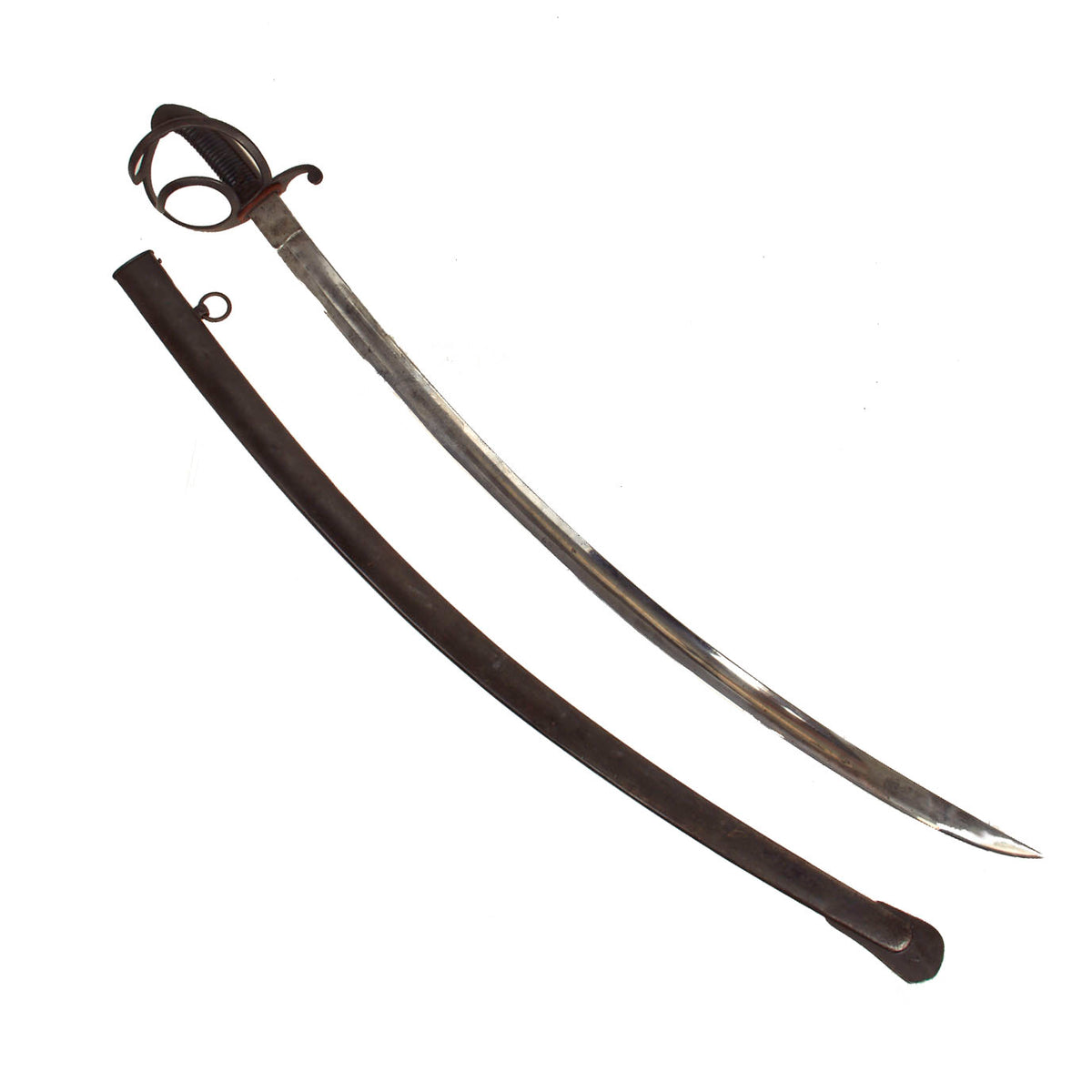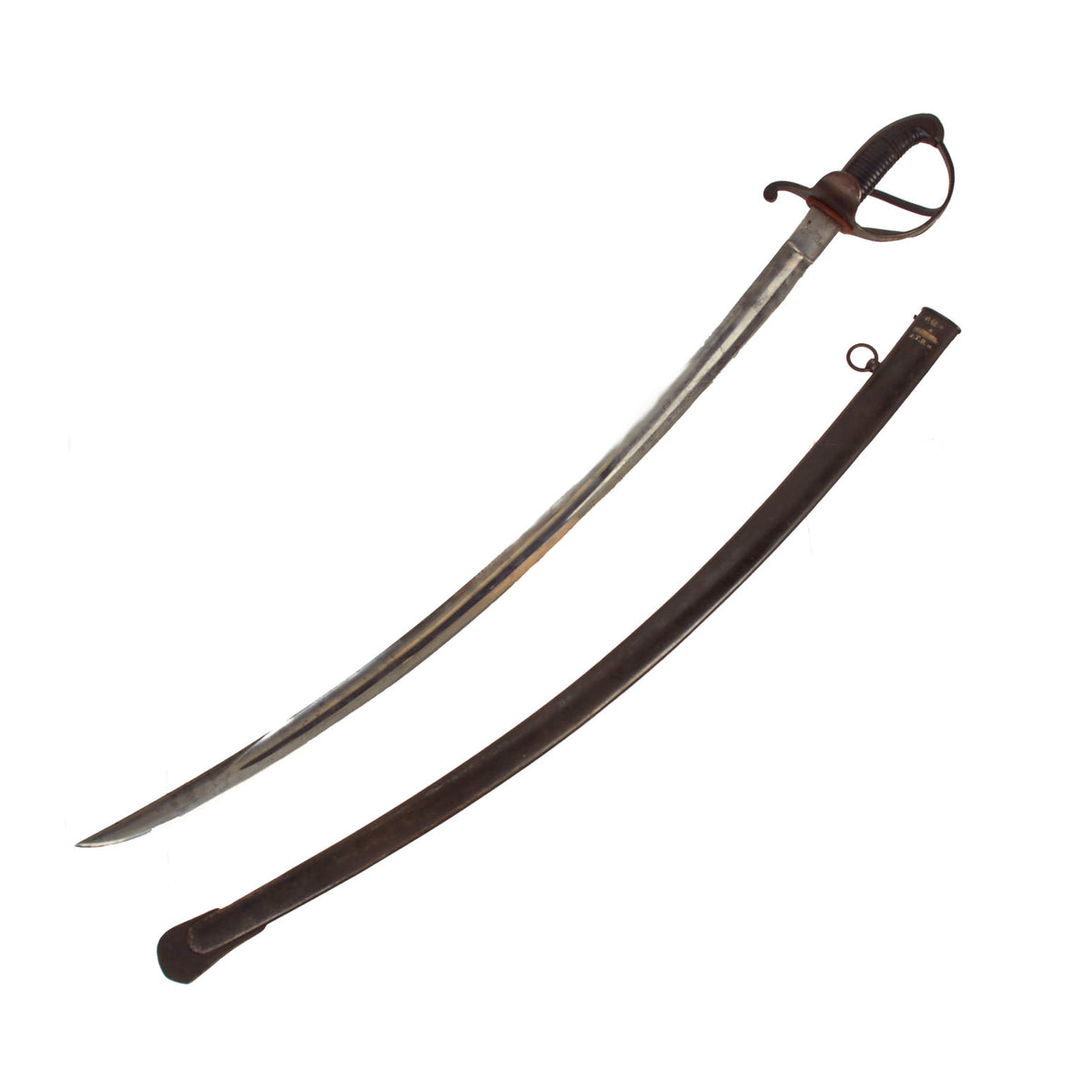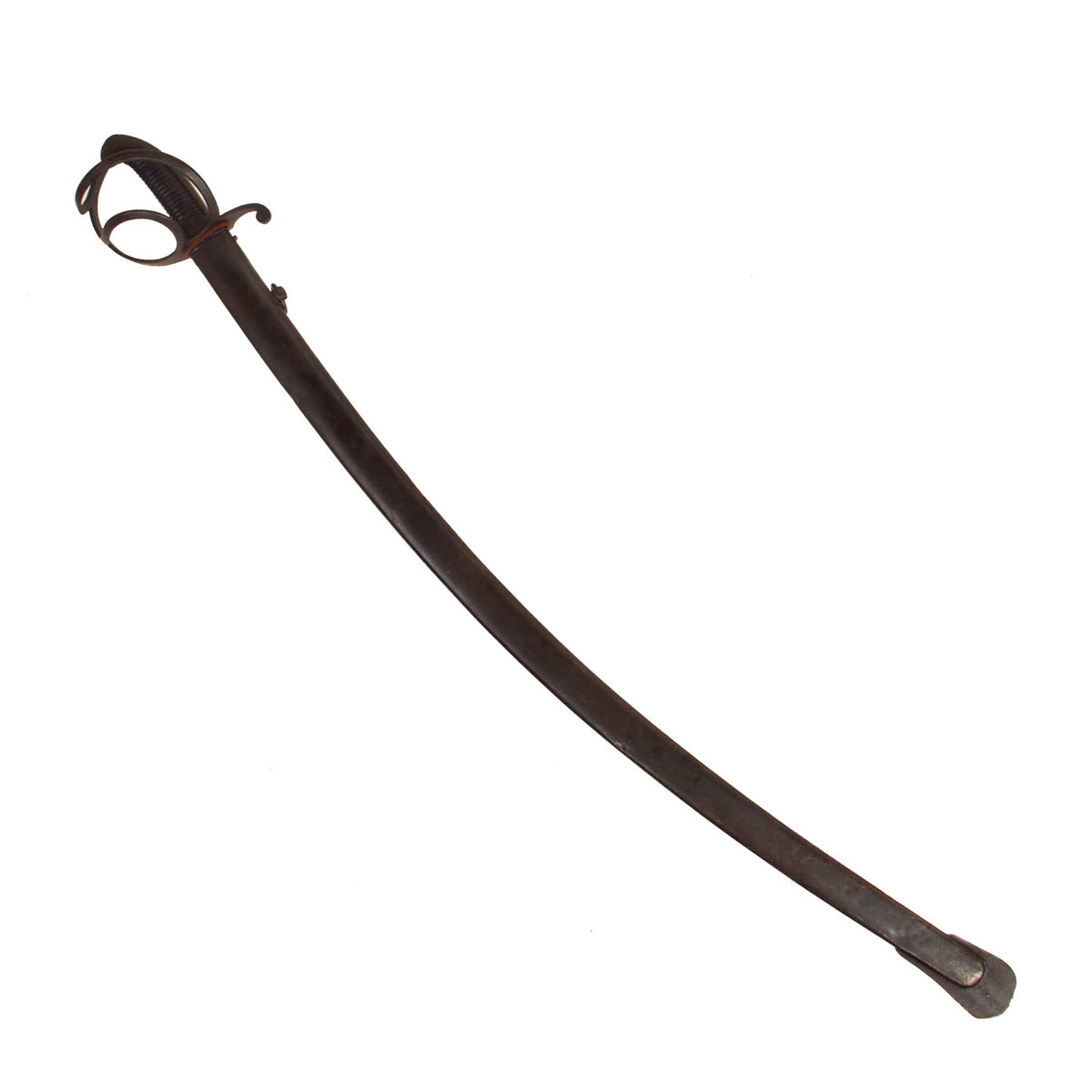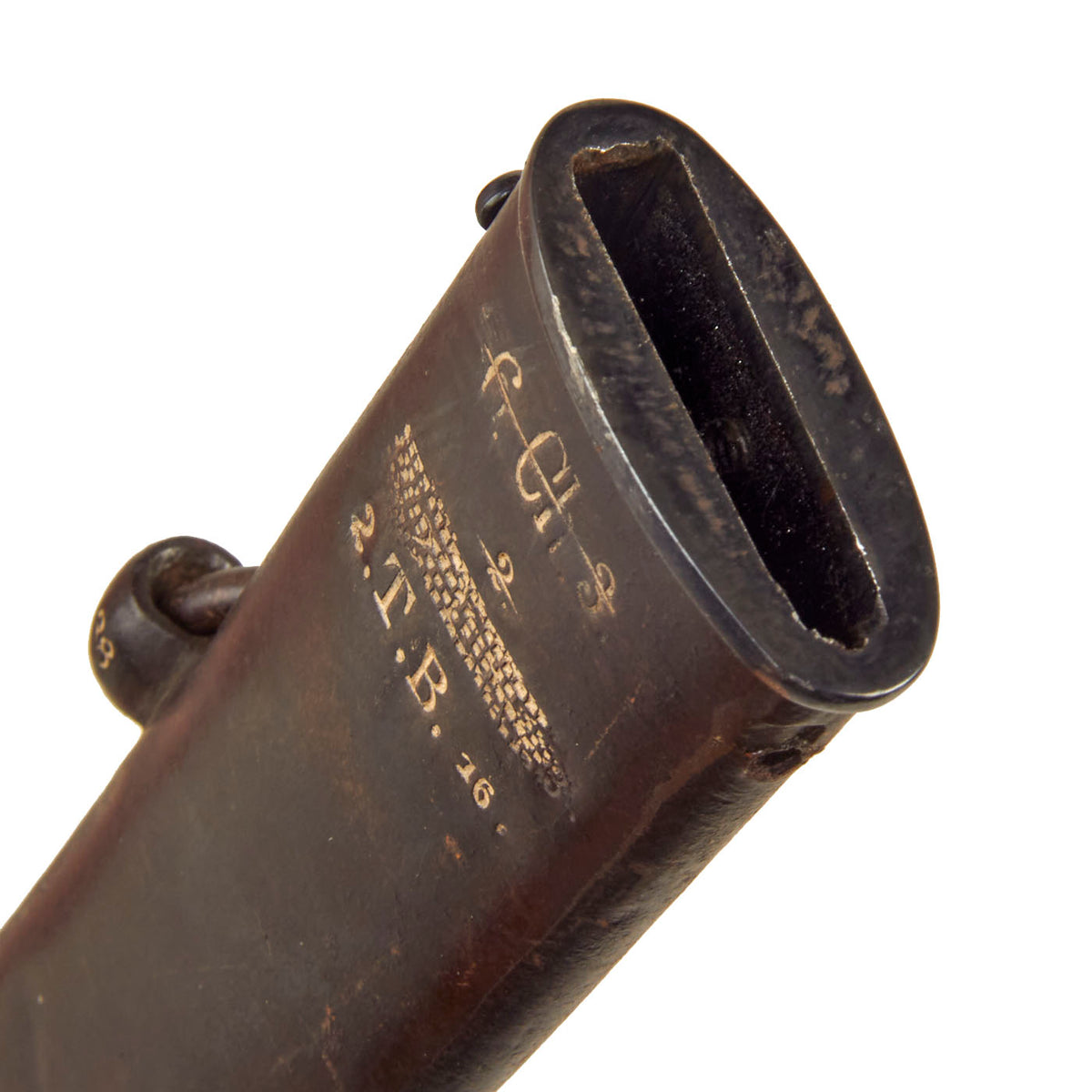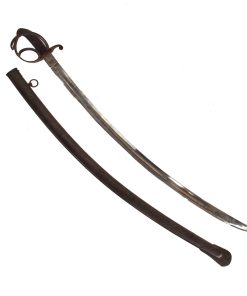Original German WWI Unit Marked Bavarian Train Battalion Officer’s M1826 Chevauleger Saber With Matching Scabbard by E&F Horster, Solingen- Dated 1894 Original Items
$ 895,00 $ 223,75
Original Item: Only One Available. The basic Infantry officers’ sword of Bavaria was the Model 1855, a simple brass B-guard with backstrap copied from the Austrian Infantry Officer’s Saber, Model 1850. The single fuller blades, like this example, are etched with the Bavarian motto In Treue Fest, “In Steadfast Loyalty”. There is also a variation of this model with a Lionhead. Since senior NCOs were granted the right to carry the Officer’s Saber, the M1855 is relatively common.
The two Bavarian Heavy Cavalry, Schwere Reiter regiments carried a number of classic Cuirassier Broadswords in both issue and interim varieties. The Bavarian Cuirassier M1825 broadsword had the classic form of knuckle-guard with three branches, exactly like this M1826. In 1891, the Bavarians introduced a new model, with a shorter blade and knuckle-guard with two branches. Unlike the Prussian Cuirassier swords, the officer and enlisted swords are more noticeably different.
The first world war involved all the states in the German Empire including Bavaria, properly known as Königreich Bayern, the Kingdom of Bavaria. Located in the southeast of Germany, Bavaria is home to notable cities such as the Capital city of Munich, Nuremberg, Augsberg, and others. During WWI, it was ruled by King Ludwig III, who ruled from 1913 up until the monarchy was abolished at the end of 1918 at the end of the war. King Ludwig III had taken the throne from his insane cousin King Otto, who in turn was descended from the famous “Mad King” Ludwig II, the builder of the original Disney World Magic Kingdom style Castle “NEUSCHWANSTEIN.” This was built between 1869 and 1876, and the cost almost bankrupted the Kingdom.
The sword is marked on the spine with the Royal Cypher of King Ludwig II which is a Crown over the letter “L”. Above the cypher is the number 94 indicating the year of manufacture of 1894. The ricasso is maker marked with E & F HORSTER / SOLINGEN.
The knuckle guard is marked with 2. T.B. 16. which we believe to be for a Train Battalion in the 2nd Royal Bavarian Corps. The sword is in great condition, with the blade’s edge still sharp, shining bright with minimal nicks present.
In military contexts, a train is the logistical transport element accompanying a military force. Often called a supply train or baggage train, it has the job of providing materiel for their associated combat forces when in the field. When focused on provision of field artillery and its ammunition, it may be termed an artillery train. For sieges, the addition of siege engines to an artillery train was called a siege train. These military terms predate, and do not imply a railway train, though railways are often employed for modern logistics, and can include armored trains.
For armies, this historically usually referred to forces employing wagons, horses, mules, oxen, camels, or even elephants. These can still be useful where difficult weather or topography limit use of railways, trucks, sealift, or airlift.
The matching scabbard bears the same unit marking by the throat and has a single suspension ring. The scabbard is in excellent condition with minor denting present throughout. The steel appears to have been blackened which was done closer to the start of the First World War.
This is an excellent example of a WWI Bavarian sword, that comes more than ready for further research and display.
Specifications:
Blade Length: 32 ¾”
Grip Length: 4”
Total Length: 38 ¾”
Scabbard Length” 35 ⅛”
Chevaulegers were originally a genus of light cavalry. In the Kingdom of Bavaria they formed the medium-heavy cavalry from 1813 and were considered the characteristic arm of the Bavarian army until the end of the monarchy. The term Chevauleger comes from the French ( chevaux = horses ; léger = light) originally from the Italian (cavalleggeri).
Fast Shipping with Professional Packaging
Thanks to our longstanding association with UPS FedEx DHL, and other major international carriers, we are able to provide a range of shipping options. Our warehouse staff is expertly trained and will wrap your products according to our exact and precise specifications. Prior to shipping, your goods will be thoroughly examined and securely secured. We ship to thousands clients each day across multiple countries. This shows how we're dedicated to be the largest retailer on the internet. Warehouses and distribution centres can be located throughout Europe as well as the USA.
Note: Orders with more than one item will be assigned a processing date depending on the item.
Before shipping before shipping, we'll conduct a thorough inspection of the items you have ordered. Today, the majority of orders will be delivered within 48 hours. The delivery time will be between 3-7 days.
Returns
The stock is dynamic and we cannot completely manage it because multiple stakeholders are involved, including our factory and warehouse. So the actual stock may alter at any time. It's possible that you may not receive your order once the order has been made.
Our policy is valid for a period of 30 days. If you don't receive the product within 30 days, we are not able to issue a refund or an exchange.
You can only return an item if it is unused and in the same state as the day you received it. You must have the item in its original packaging.
Related products
Uncategorized
Uncategorized
Uncategorized
Uncategorized
Uncategorized
Australian WWII Owen MK1 Machine Carbine SMG Custom Fabricated Replica with Sling Original Items
Uncategorized
Uncategorized
Uncategorized
Armored Burgonet Helmet & Polearm from Scottish Castle Leith Hall Circa 1700 Original Items
Uncategorized
Uncategorized
Uncategorized
Uncategorized
Uncategorized
